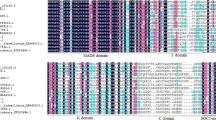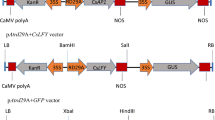Abstract
The MADS box genes SUPPRESSOR OF OVEREXPRESSION OF CONSTANS1 (SOC1) and FRUITFULL (FUL) are widely known to be involved in the determination of flowering time and the transition from vegetative to reproductive meristem identity in A. thaliana and many other plant species. Analog to the induction of SOC1 and FUL, double mutants in Arabidopsis revealed both secondary cell wall and wood formation. We tested a putative influence of the overexpression of both genes onto growth and plant habitus in the perennial genus Populus. Two different poplar hybrid clones were transformed with SOC1 from A. thaliana (AtSOC1) and FUL from Sinapis alba (SaFUL). Both genes were under the control of the CaMV-35S promoter to induce constitutive overexpression. Regenerated single and double transgenic lines were transferred to the glasshouse and cultivated for up to two vegetation periods. Parallel overexpression of both genes led to plants with a significantly restricted plant growth compared to both untransformed controls and single transgenic plants. Extreme phenotypes also exhibit a different overall habitus of plants and leaf morphology. Thus, both genes seem to be involved in plant habitus and biomass formation in poplar. This study confirms the hypothesis that the two MADS box genes SOC1 and FUL are not only part of reproductive meristem regulation but also involved in vegetative meristem growth. In the next step, downregulation of all SOC1 and FUL genes in poplar by genome editing could lead to increased plant growth and biomass formation.








Similar content being viewed by others
References
Albani MC, Coupland G (2010) Comparative analysis of flowering in annual and perennial plants. In: Timmermans MCP (ed) Current topics in developmental biology, vol 91. Academic, Oxford, pp 323–348
Araki T (2001) Transition from vegetative to reproductive phase. Curr Opin Plant Biol 4(1):63–68
Balanzà V, Martínez-Fernández I, Sato S, Yanofsky MF, Kaufmann K, Angenent GC, Bemer M, Ferrándiz C (2018) Genetic control of meristem arrest and life span in Arabidopsis by a FRUITFULL-APETALA2 pathway. Nat Commun 9(1):565
Becker A, Theissen G (2003) The major clades of MADS-box genes and their role in the development and evolution of flowering plants. Mol Phylogenet Evol 29(3):464–489
Bemer M, van Mourik H, Muiño JM, Ferrándiz C, Kaufmann K, Angenent GC (2017) FRUITFULL controls SAUR10 expression and regulates Arabidopsis growth and architecture. J Exp Bot 68(13):3391–3403
Borner R, Kampmann G, Chandler J, Gleißner R, Wisman E, Apel K, Melzer S (2000) A MADS domain gene involved in the transition to flowering in Arabidopsis. Plant J 24(5):591–599
Bradshaw HD Jr, Strauss SH (2001) Breeding strategies for the 21st century: domestication of poplar. In: Dickmann DI, Isebrands JGT, Eckenwalder JE, Richardson J (eds) Poplar culture in North America. NRC Research Press, Ottawa, pp 383–394
Bruegmann T (2016) Genetische Modifikation von SUPPRESSOR OF OVEREXPRESSION OF CONSTANS1 (SOC1), FRUITFULL (FUL) und weiterer Kandidatengene in Pappelhybriden (Populus spec.). Dissertation, University of Hamburg
Bruegmann T, Polak O, Heier K, Nietsch J, Fladung M (2018) Poplar transformation. In: Kumar S, Barone P, Smith M (eds) Transgenic plants - methods and protocols. Springer, Berlin
Bustin SA, Benes V, Garson JA, Hellemans J, Huggett J, Kubista M, Mueller R, Nolan T, Pfaffl MW, Shipley GL, Vandesompele J, Wittwer CT (2009) The MIQE guidelines: minimum information for publication of quantitative real-time PCR experiments. Clin Chem 55(4):611–622
Chang S, Puryear J, Cairney J (1993) A simple and efficient method for isolating RNA from pine trees. Plant Mol Biol Report 11(2):113–116
Demura T, Ye ZH (2010) Regulation of plant biomass production. Curr Opin Plant Biol 13(3):298–303
Ding L, Wang Y, Yu H (2013) Overexpression of DOSOC1, an ortholog of Arabidopsis SOC1, promotes flowering in the orchid Dendrobium Chao Parya Smile. Plant Cell Physiol 54(4):595–608
Dumolin S, Demesure B, Petit RJ (1995) Inheritance of chloroplast and mitochondrial genomes on pedunculate oak investigated with an efficient PCR method. Theor Appl Genet 91:1253–1256
Elo A, Lemmetyinen J, Turunen ML, Tikka L, Sopanen T (2001) Three MADS-box genes similar to APETALA1 and FRUITFULL from silver birch (Betula pendula). Physiol Plant 112:95–103
Elo A, Lemmetyinen J, Novak A, Keinonen K, Porali I, Hassinen M, Sopanen T (2007) BpMADS4 has a central role in inflorescence initiation in silver birch (Betula pendula). Physiol Plant 131:149–158
Ferrándiz C, Gu Q, Martienssen R, Yanofsky MF (2000) Redundant regulation of meristem identity and plant architecture by FRUITFULL, APETALA1 and CAULIFLOWER. Development 127(4):725–734
Flachowsky H, Peil A, Sopanen T, Elo A, Hanke V (2007) Overexpression of BpMADS4 from silver birch (Betula pendula ROTH.) induces early-flowering in apple (Malus × domestica BORKH.). Plant Breed 126(2):137–145
Flachowsky H, Hanke MV, Peil A, Strauss SH, Fladung M (2009) A review on transgenic approaches to accelerate breeding of woody plants. Plant Breed 128:217–226
Fladung M (2008) Domestikation von Bäumen: bleibende Utopie oder bald Wirklichkeit? AFZ-Der Wald 5:229–231
Fladung M, Ahuja MR (1995) “Sandwich” method for nonradioactive hybridization. Biotechniques 18(5):800–802
Fladung M, Ahuja MR (1996) Gene transfer in aspen. In: Schmidt ER, Hankeln T (eds) Transgenic organisms and biosafety. Springer, Berlin, pp 275–281
Fladung M, Polak O (2012) Ac/Ds-transposon activation tagging in poplar: a powerful tool for gene discovery. BMC Genomics 13:61
Fladung M, Kumar S, Ahuja MR (1997) Genetic transformation of Populus genotypes with different chimaeric gene constructs: transformation efficiency and molecular analysis. Transgenic Res 6:111–121
Gu Q, Ferrándiz C, Yanofsky MF, Martienssen R (1998) The FRUITFULL MADS-box gene mediates cell differentiation during Arabidopsis fruit development. Development 125(8):1509–1517
Henderson IR, Dean C (2004) Control of Arabidopsis flowering: the chill before the bloom. Development 131(16):3829–3838
Hoenicka H, Nowitzki O, Hanelt D, Fladung M (2008) Heterologous overexpression of the birch FRUITFULL-like MADS-box gene BpMADS4 prevents normal senescence and winter dormancy in Populus tremula L. Planta 227(5):1001–1011
Hong JK, Kim SY, Kim KS, Kwon SJ, Kim JS, Kim JA, Lee SI, Lee YH (2013) Overexpression of a Brassica rapa MADS-box gene, BrAGL20, induces early flowering time phenotypes in Brassica napus. Plant Biotechnol Rep 7(3):231–237
Kaltschmitt M, Hartmann H, Hofbauer H (2009) Energie aus Biomasse. Grundlagen, Techniken und Verfahren. Springer, Berlin
Kim KW, Shin JH, Moon J, Kim M, Lee J, Park MC, Lee I (2003) The function of the flowering time gene AGL20 is conserved in crucifers. Mol Cells 16(1):136–141
Kim HS, Jung MS, Lee SM, Kim KE, Byun H, Choi MS, Park HC, Cho MJ, Chung WS (2009) An S-locus receptor-like kinase plays a role as a negative regulator in plant defense responses. Biochem Biophys Res Commun 381(3):424–428
Lee S, Kim J, Han JJ, Han MJ, An G (2004) Functional analyses of the flowering time gene OsMADS50, the putative SUPPRESSOR OF OVEREXPRESSION OF CO 1/AGAMOUS-LIKE 20 (SOC1/AGL20) ortholog in rice. Plant J 38(5):754–764
Leple JC, Brasileiro ACM, Michel MF, Delmotte F, Jouanin L (1992) Transgenic poplars: expression of chimeric genes using four different constructs. Plant Cell Rep 11(3):137–141
Leseberg CH, Li A, Kang H, Duvall M, Mao L (2006) Genome-wide analysis of the MADS-box gene family in Populus trichocarpa. Gene 378:84–94
Liu YG, Mitsukawa N, Oosumi T, Whittier RF (1995) Efficient isolation and mapping of Arabidopsis thaliana T-DNA insert junctions by thermal asymmetric interlaced PCR. Plant J 8(3):457–463
Mandel MA, Yanofsky MF (1995) The Arabidopsis AGL8 MADS box gene is expressed in inflorescence meristems and is negatively regulated by APETALA1. Plant Cell 7(11):1763–1771
Melzer S, Lens F, Gennen J, Vanneste S, Rohde A, Beeckman T (2008) Flowering-time genes modulate meristem determinacy and growth form in Arabidopsis thaliana. Nat Genet 40:1489–1492
Prakash AP, Kumar PP (2002) PkMADS1 is a novel MADS box gene regulating adventitious shoot induction and vegetative shoot development in Paulownia kawakamii. Plant J 29(2):141–151
Putterill J, Laurie R, Macknight R (2004) It’s time to flower: the genetic control of flowering time. Bioessays 26(4):363–373
Ré DA, Capella M, Bonaventure G, Chan RL (2014) Arabidopsis AtHB7 and AtHB12 evolved divergently to fine tune processes associated with growth and responses to water stress. BMC Plant Biol 14(1):150
Salehi H, Ransom CB, Oraby HF, Seddighi Z, Sticklen MB (2005) Delay in flowering and increase in biomass of transgenic tobacco expressing the Arabidopsis floral repressor gene FLOWERING LOCUS C. J Plant Physiol 162:711–717
Schrader J, Nilsson J, Mellerowicz E, Berglund A, Nilsson P, Hertzberg M, Sandberg G (2004) A high-resolution transcript profile across the wood-forming meristem of poplar identifies potential regulators of cambial stem cell identity. Plant Cell 16(9):2278–2292
Southern EM (1975) Detection of specific sequences among DNA fragments separated by gel electrophoresis. J Mol Biol 98(3):503–517
Sreekantan L, Thomas MR (2006) VvFT and VvMADS8, the grapevine homologues of the floral integrators FT and SOC1, have unique expression patterns in grapevine and hasten flowering in Arabidopsis. Funct Plant Biol 33(12):1129–1139
Srikanth A, Schmid M (2011) Regulation of flowering time: all roads lead to Rome. Cell Mol Life Sci 68(12):2013–2037
Theissen G, Becker A, Di Rosa A et al (2000) A short history of MADS-box genes in plants. In: Doyle JJ, Gaut BS (eds) Plant molecular evolution. Springer, Dordrecht, pp 115–149
Tuskan GA, DiFazio S, Jansson S, Bohlmann J, Grigoriev I, Hellsten U, Putnam N, Ralph S, Rombauts S, Salamov A, Schein J, Sterck L, Aerts A, Bhalerao RR, Bhalerao RP, Blaudez D, Boerjan W, Brun A, Brunner A, Busov V, Campbell M, Carlson J, Chalot M, Chapman J, Chen GL, Cooper D, Coutinho PM, Couturier J, Covert S, Cronk Q, Cunningham R, Davis J, Degroeve S, Dejardin A, dePamphilis C, Detter J, Dirks B, Dubchak I, Duplessis S, Ehlting J, Ellis B, Gendler K, Goodstein D, Gribskov M, Grimwood J, Groover A, Gunter L, Hamberger B, Heinze B, Helariutta Y, Henrissat B, Holligan D, Holt R, Huang W, Islam-Faridi N, Jones S, Jones-Rhoades M, Jorgensen R, Joshi C, Kangasjarvi J, Karlsson J, Kelleher C, Kirkpatrick R, Kirst M, Kohler A, Kalluri U, Larimer F, Leebens-Mack J, Leple JC, Locascio P, Lou Y, Lucas S, Martin F, Montanini B, Napoli C, Nelson DR, Nelson C, Nieminen K, Nilsson O, Pereda V, Peter G, Philippe R, Pilate G, Poliakov A, Razumovskaya J, Richardson P, Rinaldi C, Ritland K, Rouze P, Ryaboy D, Schmutz J, Schrader J, Segerman B, Shin H, Siddiqui A, Sterky F, Terry A, Tsai CJ, Uberbacher E, Unneberg P, Vahala J, Wall K, Wessler S, Yang G, Yin T, Douglas C, Marra M, Sandberg G, van de Peer Y, Rokhsar D (2006) The genome of black cottonwood, Populus trichocarpa (Torr. & Gray). Science 313:1596–1604
Xue LJ, Alabady MS, Mohebbi M, Tsai CJ (2015) Exploiting genome variation to improve next-generation sequencing data analysis and genome editing efficiency in Populus tremula × alba 717-1B4. Tree Genet Genomes 11(4):1–8
Acknowledgements
We are grateful to Siegbert Melzer (Christian-Albrechts-Universität, Kiel, Germany) for providing the SaFUL and AtFUL overexpression transformation vectors. Thanks to Olaf Polak and Susanne Jelkmann for outstanding laboratory work. Thanks to Gundel Wiemann, Monika Spauszus, Matthias Hunger, Rainer Ebbinghaus, and Dr. Wolfgang Graf for technical assistance in the glasshouse as well as to Jennifer Lüneburg, Denise Lehnhardt, Doris Ebbinghaus, Anke Schellhorn, and Angelika Worm for their support in the laboratory. This work was part of the joint project “PopMass,” funded by the German Federal Ministry of Education and Research (BMBF) under the funding number 0315972A. The responsibility for the content rests with the authors.
Data archiving statement
Primer sequences used in this study can be found in Online Resource 2.
Author information
Authors and Affiliations
Corresponding author
Ethics declarations
Conflict of interest
The authors declare that they have no conflict of interest.
Additional information
Communicated by A. Brunner
Publisher’s note
Springer Nature remains neutral with regard to jurisdictional claims in published maps and institutional affiliations.
Rights and permissions
About this article
Cite this article
Bruegmann, T., Fladung, M. Overexpression of both flowering time genes AtSOC1 and SaFUL revealed huge influence onto plant habitus in poplar. Tree Genetics & Genomes 15, 20 (2019). https://doi.org/10.1007/s11295-019-1326-9
Received:
Revised:
Accepted:
Published:
DOI: https://doi.org/10.1007/s11295-019-1326-9




